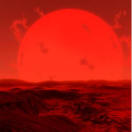After spending varying amounts of time on the main sequence, virtually all stars will become unstable, and proceed to new ways of creating energy,
Most star enter a new stage of life as a red giant. After initially becoming a red giant, many stars will go through an unstable period where it pulsates
as a Cepheid variable, a type of object first studied by Henrietta Leavitt, one of the first women to gain credence in the astronomical community. The
value of Cepheids is that they allow us to calculate distances. For most of a star’s life, it is in hydrostatic equilibrium. At the end of a star’s time on
the main sequence, changes are occurring in the interior. After a time, helium collects in the core of a star, causing the region of thermonuclear fusion
to move farther from the center. That causes the surface of a star to heat and expand, resulting in an increase in diameter to dozens if not hundreds of
times the original size.
Betelguese is a famous Red Giant in Orion that is roughly six hundred times the diameter of the Sun. The largest stars are even bigger than that. These dying stars
are seen as red giants. Red Giant stars are nearly at the end of their lifetimes. As the core of waste helium continues to compress and become heated, eventually it
reaches the magic temperature of 100 million Kelvin resulting in a sudden onset of helium fusion into carbon, the Helium Flash.

Looking for a particular star? Find it here!


Red Giants


























